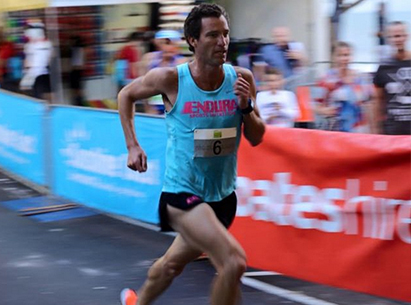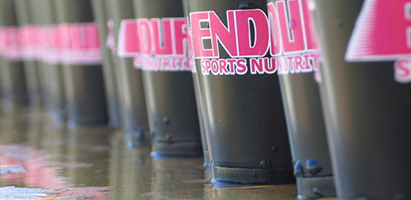
Tip 1: Stay Focused and Positive
Mental strength is what sets you apart as an endurance athlete, therefore the ability to remain focused and positive is absolutely critical to a successful race. If you struggle to avoid negative thoughts during a race, consider the following four pointers:
- ‘Where the mind goes the body follows’1 - The trick to managing negative thoughts is recognising you have the power to silence them.2 Interrupt negative thoughts with motivating symbols, mantras (e.g. ‘yes I can’) or songs. Decide on what works to help you nullify negative thoughts and unleash your mantra if your inner voice turns nasty.
- Set a goal range - The top of the goal range represents your perfect race (e.g. complete the marathon within 3.5 hours). The bottom represents the minimum achievement that you would be satisfied with in suboptimal conditions (e.g. complete the marathon). Setting a goal range relieves unnecessary pressure whilst still helping you strive for excellence.
- Be your own cheer-leader - Positive self-talk is a powerful tool to help you remain optimistic and keep yourself on track. Encourage yourself, urge yourself on, remind yourself of your achievements so far.
- Distract yourself - Take your mind off the pain by admiring the scenery, looking at spectator’s smiles, singing an inspiring song, focusing on your technique/breathing, setting small goals and focusing on achieving them.
Mastering the mental aspects of a race takes practice and perseverance. Work on remaining focused and positive during every training session so that when race day arrives, you will be prepared to utilise the power of positivity.
Tip 2: Maintain a Consistent Pace

A major key to running a great endurance race is to maintain a good, consistent pace. Developing a consistent pace takes practice and may take time to master, however it is crucial for endurance events to prevent premature fatigue and help you achieve your best race times. Read on for some tips on developing a good race pace:
- Plan your path: Consider the total time within which you are aiming to complete your race, then break the race into smaller chunks (e.g. into kilometres or between drink stops). Decide what times you aim to complete each chunk in to achieve your total race time.
- Work the plan: Once you have your timing planned out, train like a Trojan to become familiar with what your desired pace feels like.
- Change it up: Train at faster and slower speeds than your desired pace to get a sense of what alternate paces feel like. This will help you detect the need to accelerate or decelerate to maintain your ideal speed.
- Keep pace with technology: There are a number of devices available to help you monitor your pace while on the go. Options range from the humble wrist watch to advanced GPS watches that tell you how far and how fast you are travelling.
Pacing is something you need to practice repeatedly. As you train week in and week out, good pacing will become more natural and you will start maximising your performance.
Tip 3: Take Advantage of the Rehydration Stations

Drink stations are set up along the course of every endurance race for your benefit; nevertheless, there is a bit of skill involved in grabbing a cup and drinking while on the run. Here are a couple of tips to help you get the most out of the rehydration stations:
- Practice during training - Drinking on the run can be harder than you realise, especially if you don’t plan on slowing down. Practice grabbing a cup from a table (or volunteer) and manoeuvring it to your mouth for a drink without slowing down, allowing you to maintain a competitive pace without compromising hydration.
- Slow down - Slow down, to a walk if necessary, to make sure you are able to have a proper drink, rather than just a sip. Losing a couple of seconds to achieve a sufficient drink break is preferable to becoming dehydrated.
- Take a drink at every station - Even if you do not feel thirsty it is important to have a drink at every station, as the effects of dehydration can begin to set in before thirst appears, significantly affecting your performance.
Drink stations can be a source of re-invigoration during a long, hard race and are crucial to help you ward off the potentially serious consequences of dehydration. Take full advantage of every drink station you encounter along the trail to ensure you remain at the top of your game.
Tip 4: Carry Endura Gels for Lasting Energy
Endurance sports are characterised by events that push an athlete’s body to its limits, so it makes sense that endurance athletes utilise all the support they can get. To prevent bonking and running out of muscle fuel, athletes need to consume adequate amounts of carbohydrates during a race. Endura Sports Energy Gels are designed to provide the shot of energy that an endurance athlete needs to last the distance. Each serve of Endura Gels provides 26 g of rapid and sustained-release carbohydrates with a touch of caffeine, to provide both instant and lasting energy. The convenient 35 g sachets make them ideal to carry in your pockets or belt, or pin to your pants or bib. Consuming Endura Gels without water will likely result in digestive upset and impede performance, therefore for best results ensure you take an Endura Gel sachet every 30 to 60 minutes with 300 mL of water. For a delicious, convenient fuel source that will help power your body to your physical limits, go no further than Endura Sports Energy Gels.